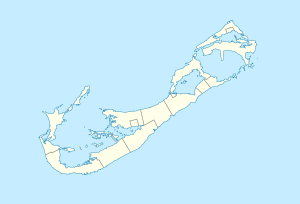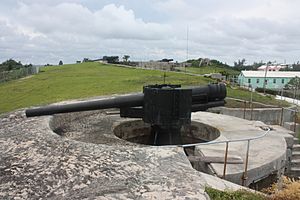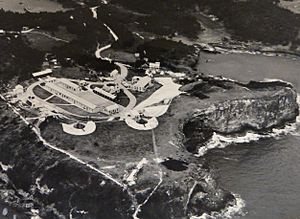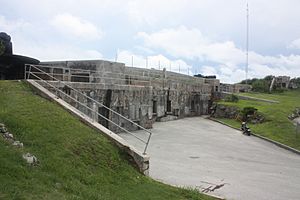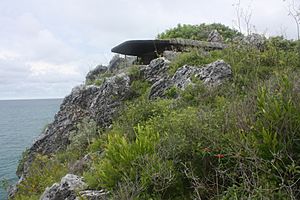St David's Battery facts for kids
Quick facts for kids St. David's Battery |
|
|---|---|
| Part of Bermuda Garrison | |
| St. David's, Bermuda | |

No. 2 9.2-inch gun at St. David's Battery (or the Examination Battery), in 2011. Two 6 inch guns are visible behind.
|
|
| Coordinates | 32°22′N 64°39′W / 32.37°N 64.65°W |
| Type | Artillery Battery |
| Site information | |
| Owner | Government of Bermuda Ministry of the Environment, Telecommunications and E-Commerce, Department of Parks |
| Open to the public |
yes |
| Site history | |
| Built | 1910 |
| Built by | Royal Engineers |
| In use | 1910–1953 |
| Garrison information | |
| Garrison | Bermuda Garrison |
St. David's Battery is an old military fort in Bermuda. During wars, it was also called the "Examination Battery." It was a special type of gun battery with powerful rifled breech-loader (RBL) guns. These guns were built and operated by soldiers from the Royal Garrison Artillery and the Royal Engineers. Local part-time soldiers from the Bermuda Militia Artillery and the Bermuda Volunteer Engineers also helped. This battery was an important part of the Bermuda Garrison of the British Army.
Contents
History of St. David's Battery
St. David's Battery was one of the last and most important forts built by the British Army. It was finished in 1910. Its main job was to protect the British colony of Bermuda and its important naval base, the Royal Naval Dockyard. Many other forts had been built over the centuries to protect Bermuda.
Older forts used different types of guns, like cannons or rifled muzzle-loading guns. But St. David's Battery was special because it was the first one designed specifically for the newer, more powerful rifled breech-loader guns.
Powerful Guns and Location
The battery had two large 9.2-inch Mk. X guns and two BL 6-inch Mk VII guns. All these guns could turn a full 360 degrees. They were made by a company called Vickers.
St. David's Battery is located on top of Great Head. This is a high point at the eastern end of St. David's Island. Bermuda is surrounded by a large coral reef. This reef protects the island but also makes it tricky for large ships to get close. There is only one main channel through the reefs for big ships. This channel brings them very close to St. David's Island. From there, ships can go into St. George's Harbour or continue to other important areas like the Royal Naval Dockyard.
The British Army built many forts in Bermuda to protect the Royal Navy's base. St. David's Head was the most important spot. It guarded the narrow channel that any enemy ships would have to use to reach the island.
The "Examination Battery" Role
During both World War I and World War II, St. David's Battery had a special job. It was called the "examination battery." When ships arrived near Bermuda, a Royal Navy officer would go out to meet them. The ships had to stop under the watchful eyes of the gunners at St. David's Head. The naval officer would check the ship and its papers. Only after this check was completed could the ship continue into Bermuda's waters.
First Shot Fired in World War I
The battery fired its first shot during World War I. This happened shortly after Britain declared war on Germany in August 1914. The British yacht Shamrock IV was sailing to Bermuda for a famous sailing race called the America's Cup. It was traveling with another ship, the Erin.
An American yacht, Vagrant, came to Bermuda to meet them. The crew of Vagrant didn't know that war had started. When they arrived, they found that all the navigation buoys (markers in the water) were gone. They tried to find their own way through the reefs. This led them right in front of St. David's Battery. The gunners, ready for war, fired a warning shot. This shot made the Vagrant stop. The Shamrock IV and Erin arrived the next day. The America's Cup race was canceled that year.
Manning the Battery Over Time
At first, full-time soldiers from the Royal Garrison Artillery operated the battery. They were supported by part-time soldiers from the Bermuda Militia Artillery (BMA). After World War I, fewer regular soldiers were stationed there. The BMA eventually took full responsibility for the guns. However, the searchlights used for night firing were operated by the Bermuda Volunteer Engineers.
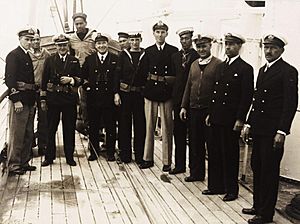
An Accidental Barrage
In 1936, St. David's Battery was involved in a strange incident. Soldiers from the BMA were supposed to fire a salute for the death of King George V. They needed to fire 70 blank rounds, one for each year of the King's life. However, they only had 23 blank rounds. For the rest, they had to use real ammunition.
They decided to fire the real rounds high up and out to sea, thinking no ships would be there. But a Colombian Navy destroyer, the ARC Antioquia, was arriving in Bermuda for repairs. The ship's crew was very surprised to find themselves under an artillery barrage! Luckily, the ship was not hit.
St. David's Battery in World War II
By World War II, St. David's Battery was the only fort in Bermuda ready for action. Only its two 6-inch guns were still actively used. It remained the main coastal artillery battery until the US Army brought its own guns to Bermuda in 1942.
The guns were placed so they were hard to see from far away. The battery also had underground rooms called magazines. These magazines stored ammunition and used lifts to bring it up to the guns. Behind the guns were barracks for the soldiers and a parade ground.
End of Service
In 1953, a decision was made to close the Royal Naval Dockyard in Bermuda. Because of this, the need for coastal artillery like St. David's Battery ended. The last regular British soldiers left in 1957. The two 6-inch guns at St. David's Battery were taken out of service. The Bermuda Militia Artillery then changed its role to an infantry (foot soldier) unit.
St. David's Battery Today
Today, St. David's Battery is still there, but it is no longer used by the military. The two 9.2-inch and two 6-inch guns are still in place. However, they have suffered a lot of damage from rust over the years. The 6-inch guns used to have metal shields for protection, but these have been removed because they were so damaged.
The area is now a public park called Great Head Park. The park service has made some repairs and painted the guns to help protect them. The parts of the 9.2-inch guns that load the ammunition have even been replaced with new ones. The old barracks and other buildings behind the battery are now used for a kindergarten school and homes.
Even though the ammunition magazines are locked, people can visit the guns at the battery for free. It's a great place to learn about Bermuda's military history.


